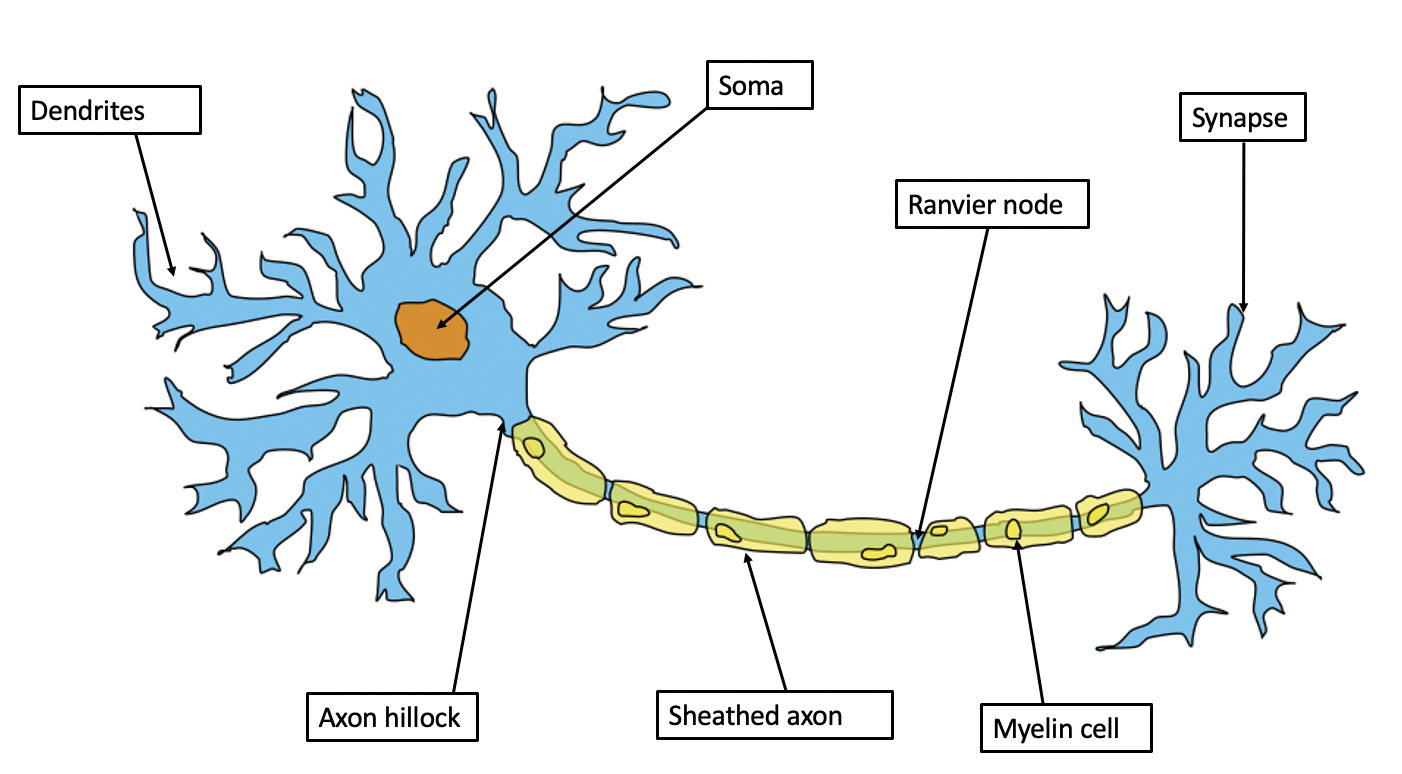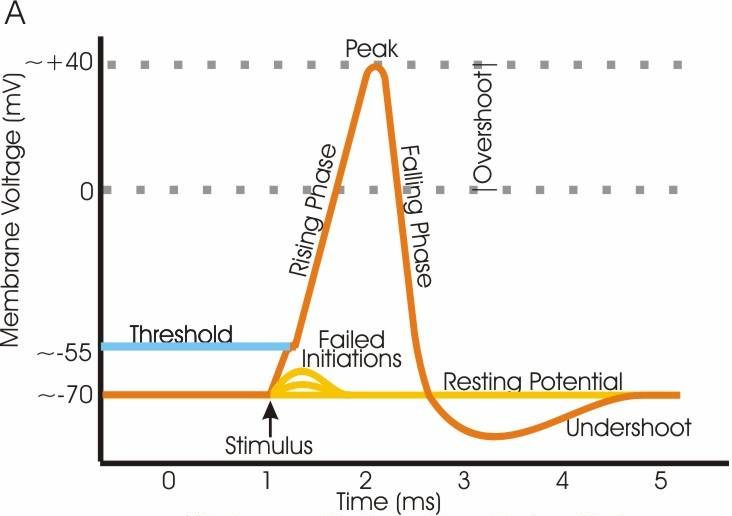Neurons
Kobe Christensen and Jim Hutchins
THE NEURON
Introduction
The neuron is an excitable cell responsible for the transmission of information throughout the body. This is possible due to their ability to manipulate their membrane potentials into electrical signals called action potentials that are quickly transmitted through the body. Neurons are considered to be the “Thinking” cells of the nervous system and are responsible for receiving, processing, and transmitting information all throughout the body.

BrunelloN, CC BY-SA 4.0 https://creativecommons.org/licenses/by-sa/4.0, via Wikimedia Commons
Neuron Components
Soma (Cell Body)
- The Soma, like most cells is the home of the nucleus and most organelles.
Dendrites
- Receive incoming information.
Axon Hillock
- Where the axon begins and where action potentials are initiated.
Axon
- Transmits action potentials.
Axon Terminal
- Releases neurotransmitters.
Synapse
- Where two neurons, or a neuron and effector organ communicate. This is the space where neurotransmitters are released and signals are sent between two neurons.
Membrane Potential
A membrane potential is defined as the difference in voltage between the inside and outside of a cell. This voltage is determined by ions that exist inside and outside of the cell. In the case of the neuron, there are more negative charges inside of the neuron when compared to the outside of the neuron thus the resting membrane potential of a neuron is negative. The resting membrane potential of a neuron is approximately -70mV (Millivolts).
The resting membrane potential is determined through ion concentration gradients. The major ions responsible for membrane potential are:
Potassium (K+) – More abundant inside of the cell contributing a positive charge. Because there is more potassium inside of the cell, potassium wants to leave the cell.
Sodium (Na+) – More abundant outside of the cell contributing a positive charge. Because there is more sodium outside of the cell, sodium wants to enter the cell.
Amino Acids (A-) – More abundant inside of the cell and contributing a negative charge. Because there are so many amino acids inside of the cell contributing a negative charge, the inside of the cell has an overall negative charge despite having more potassium (K+) which is positive.
smonsays, CC BY-SA 4.0 https://creativecommons.org/licenses/by-sa/4.0, via Wikimedia Commons
Changing Membrane Potential
In order for a neuron to send information in the form of an action potential, it must first change its membrane potential. The neuron changes its membrane potential using gated ion channels that can allow ions to pass into and out of the cell.
In the case of neurons there are two main types of ion channels.
Ligand-Gated Channels
- Generally found in dendrites or on the soma.
- Open or close in response to a chemical messenger.
Voltage-Gated Channels
- Found through the entire neuron, but most concentrated along the axon.
- Open or close in response to changes in membrane potential.
- Responsible for the transmission of an action potential.
- Two main types of voltage-gated ion channels (Sodium & Potassium)
The Action Potential

http://en.wikipedia.org/wiki/User:Memenen, CC BY-SA 3.0 https://creativecommons.org/licenses/by-sa/3.0, via Wikimedia Commons
An action potential is an electrical signal used to transmit information between neurons. An action potential can only be initiated if the neuron changes its membrane potential to exceed the threshold. Once threshold has been reached, an action potential will be fired and travel along the axon to the axon terminal. The process of firing an action potential occurs in three steps.
Rising Phase (Depolarization)
We know that the inside of a neuron is around -70mV. In order to make the neuron more positive, it means that positive charges must flow into the cell. This is exactly what happens during the first phase of an action potential called depolarization. During depolarization, voltage-gated sodium channels open which allows sodium (Na+) to rush into the cell. This causes membrane potential to reach approximately +35mV and voltage-gated sodium channels close.
Falling Phase (Repolarization)
Now that sodium (Na+) has rushed into the cell from the rising phase (Depolarization), the membrane potential is now approximately +35mV. In order for the neuron to return to its resting membrane potential of -70mV it must lose some of its positive charge. The neuron does this by opening voltage-gated potassium channels. Because there is more potassium (K+) inside of the cell, it will want to rush out of the cell and as the cell loses these positive charges the membrane potential decreases back to it’s original resting potential of -70mV.
Undershoot (Hyperpolarization)
Hyperpolarization occurs because voltage-gated potassium channels are slow to close resulting in more potassium (K+) leaving the cell. As the cell continues to lose these positive charges it becomes even more negative than -70mV for a short period of time.
Key Takeaways
- Neurons are responsible for receiving, processing, and transmitting information in the nervous system.
- Neurons transmit information using electrical signals called action potentials.
- An action potential occurs in 3 phases: Depolarization, Repolarization, Hyperpolarization.
- Depolarization is a result of sodium (Na+) channels opening and allowing sodium into the cell.
- Repolarization is a result of potassium (K+) channels opening and allowing potassium to leave the cell.
- Hyperpolarization is a result of potassium (K+) channels being slow to close and allowing membrane potential to dip below -70mV.

